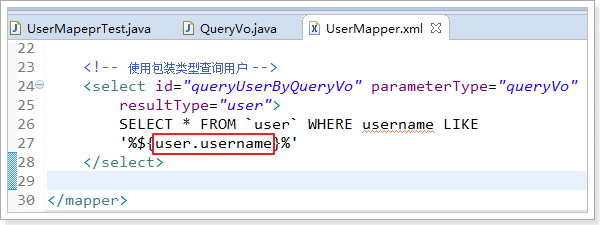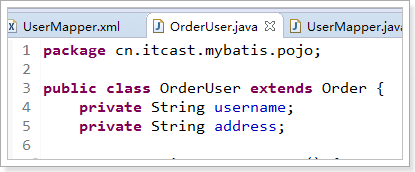1.输入映射和输出映射
(1)传递pojo包装对象(pojo中的一个属性是一个pojo)
public class QueryVo {
// 包含其他的pojo
private User user;
public User getUser() {
return user;
}
public void setUser(User user) {
this.user = user;
}
}

(2)resultMap
resultType可以指定将查询结果映射为pojo,但需要pojo的属性名和sql查询的列名一致方可映射成功。
如果sql查询字段名和pojo的属性名不一致,可以通过resultMap将字段名和属性名作一个对应关系 ,resultMap实质上还需要将查询结果映射到pojo对象中。
<?xml version="1.0" encoding="UTF-8" ?>
<!DOCTYPE mapper
PUBLIC "-//mybatis.org//DTD Mapper 3.0//EN"
"http://mybatis.org/dtd/mybatis-3-mapper.dtd">
<!-- namespace:命名空间,用于隔离sql,还有一个很重要的作用,Mapper动态代理开发的时候使用,需要指定Mapper的类路径 -->
<mapper namespace="cn.itcast.mybatis.mapper.OrderMapper">
<!-- resultMap最终还是要将结果映射到pojo上,type就是指定映射到哪一个pojo -->
<!-- id:设置ResultMap的id -->
<resultMap type="order" id="orderResultMap">
<!-- 定义主键 ,非常重要。如果是多个字段,则定义多个id -->
<!-- property:主键在pojo中的属性名 -->
<!-- column:主键在数据库中的列名 -->
<id property="id" column="id" />
<!-- 定义普通属性 -->
<result property="userId" column="user_id" />
<result property="number" column="number" />
<result property="createtime" column="createtime" />
<result property="note" column="note" />
</resultMap>
<!-- 查询所有的订单数据 -->
<select id="queryOrderAll" resultMap="orderResultMap">
SELECT id, user_id,
number,
createtime, note FROM `order`
</select>
</mapper>
2.动态SQL
(1)if标签,where标签
需求:根据性别和名字查询用户
查询sql:
SELECT id, username, birthday, sex, address FROM `user` WHERE sex = 1 AND username LIKE '%张%'
UserMapper.xml配置sql,如下:
<!-- 根据条件查询用户 -->
<select id="queryUserByWhere" parameterType="user" resultType="user">
SELECT id, username, birthday, sex, address FROM `user`
WHERE 1=1
<if test="sex != null and sex != ''">
AND sex = #{sex}
</if>
<if test="username != null and username != ''">
AND username LIKE
'%${username}%'
</if>
</select>
去掉1=1,改进:
<!-- 根据条件查询用户 -->
<select id="queryUserByWhere" parameterType="user" resultType="user">
SELECT id, username, birthday, sex, address FROM `user`
<!-- where标签可以自动添加where,同时处理sql语句中第一个and关键字 -->
<where>
<if test="sex != null">
AND sex = #{sex}
</if>
<if test="username != null and username != ''">
AND username LIKE
'%${username}%'
</if>
</where>
</select>
(2)SQL片段
Sql中可将重复的sql提取出来,使用时用include引用即可,最终达到sql重用的目的。
<!-- 根据条件查询用户 -->
<select id="queryUserByWhere" parameterType="user" resultType="user">
<!-- SELECT id, username, birthday, sex, address FROM `user` -->
<!-- 使用include标签加载sql片段;refid是sql片段id -->
SELECT <include refid="userFields" /> FROM `user`
<!-- where标签可以自动添加where关键字,同时处理sql语句中第一个and关键字 -->
<where>
<if test="sex != null">
AND sex = #{sex}
</if>
<if test="username != null and username != ''">
AND username LIKE
'%${username}%'
</if>
</where>
</select>
<!-- 声明sql片段 -->
<sql id="userFields">
id, username, birthday, sex, address
</sql>
(3)foreach标签
例如:select * from user where id in (1,2,3)
public class QueryVo {
public Customer customer;
public List<Integer> ids;
public Long[] IdArray;<!-- 根据ids查询用户 -->
<select id="queryUserByIds" parameterType="queryVo" resultType="user">
SELECT * FROM `user`
<where>
<!-- foreach标签,进行遍历 -->
<!-- collection:遍历的集合,这里是QueryVo的ids属性 -->
<!-- item:遍历的项目,可以随便写,,但是和后面的#{}里面要一致 -->
<!-- open:在前面添加的sql片段 -->
<!-- close:在结尾处添加的sql片段 -->
<!-- separator:指定遍历的元素之间使用的分隔符 -->
<foreach collection="ids" item="item" open="id IN (" close=")" separator=",">
#{item}
</foreach>
</where>
</select>
注意:如果要遍历QueryVo里的数组,collection要写array。
3.关联查询
(1)一对一
需求:查询所有订单信息,关联查询下单用户信息
SELECT
o.id,
o.user_id userId,
o.number,
o.createtime,
o.note,
u.username,
u.address
FROM
`order` o
LEFT JOIN `user` u ON o.user_id = u.id
方法一:使用resultType
使用resultType,改造订单pojo类,此pojo类中包括了订单信息和用户信息,这样返回对象的时候,mybatis自动把用户信息也注入进来了
OrderUser类继承Order类后OrderUser类包括了Order类的所有字段,只需要定义用户的信息字段即可,如下图:

在UserMapper.xml添加sql,如下:
<!-- 查询订单,同时包含用户数据 -->
<select id="queryOrderUser" resultType="orderUser">
SELECT
o.id,
o.user_id
userId,
o.number,
o.createtime,
o.note,
u.username,
u.address
FROM
`order` o
LEFT JOIN `user` u ON o.user_id = u.id
</select>
定义专门的pojo类作为输出类型,其中定义了sql查询结果集所有的字段。此方法较为简单,企业中使用普遍。
方式二:使用resultMap
在Order类中加入User属性,user属性中用于存储关联查询的用户信息,因为订单关联查询用户是一对一关系,所以这里使用单个User对象存储关联查询的用户信息。
映射文件如下:
<resultMap type="order" id="orderUserResultMap">
<id property="id" column="id" />
<result property="userId" column="user_id" />
<result property="number" column="number" />
<result property="createtime" column="createtime" />
<result property="note" column="note" />
<!-- association :配置一对一属性 -->
<!-- property:order里面的User属性名 -->
<!-- javaType:属性类型 -->
<association property="user" javaType="user">
<!-- id:声明主键,表示user_id是关联查询对象的唯一标识-->
<id property="id" column="user_id" />
<result property="username" column="username" />
<result property="address" column="address" />
</association>
</resultMap>
<!-- 一对一关联,查询订单,订单内部包含用户属性 -->
<select id="queryOrderUserResultMap" resultMap="orderUserResultMap">
SELECT
o.id,
o.user_id,
o.number,
o.createtime,
o.note,
u.username,
u.address
FROM
`order` o
LEFT JOIN `user` u ON o.user_id = u.id
</select>
(2)一对多
案例:查询所有用户信息及用户关联的订单信息。用户信息和订单信息为一对多关系。
SELECT
u.id,
u.username,
u.birthday,
u.sex,
u.address,
o.id oid,
o.number,
o.createtime,
o.note
FROM
`user` u
LEFT JOIN `order` o ON u.id = o.user_id
此处使用resultMap完成映射(实际开发中倾向使用resultType完成映射,因为对user.java没有更改,而是新建实体类继承user.java)
<resultMap type="user" id="userOrderResultMap">
<id property="id" column="id" />
<result property="username" column="username" />
<result property="birthday" column="birthday" />
<result property="sex" column="sex" />
<result property="address" column="address" />
<!-- 配置一对多的关系 -->
<collection property="orders" javaType="list" ofType="order">
<!-- 配置主键,是关联Order的唯一标识 -->
<id property="id" column="oid" />
<result property="number" column="number" />
<result property="createtime" column="createtime" />
<result property="note" column="note" />
</collection>
</resultMap>
<!-- 一对多关联,查询订单同时查询该用户下的订单 -->
<select id="queryUserOrder" resultMap="userOrderResultMap">
SELECT
u.id,
u.username,
u.birthday,
u.sex,
u.address,
o.id oid,
o.number,
o.createtime,
o.note
FROM
`user` u
LEFT JOIN `order` o ON u.id = o.user_id
</select>
4.Mybatis整合Spring
(1)整合思路
- SqlSessionFactory对象应该放到spring容器中作为单例存在。
- 传统dao的开发方式中,应该从spring容器中获得sqlsession对象。
- Mapper代理形式中,应该从spring容器中直接获得mapper的代理对象。
- 数据库的连接以及数据库连接池事务管理都交给spring容器来完成。
(2)整合需要的jar包
- spring的jar包
- Mybatis的jar包
- Spring+mybatis的整合包。
- Mysql的数据库驱动jar包。
- 数据库连接池的jar包。
(3)整合步骤
(3.1)创建一个Java工程,导入jar包。
(3.2)加入配置文件
Mybatis核心配置文件SqlMapConfig.xml,如下:
<?xml version="1.0" encoding="UTF-8" ?>
<!DOCTYPE configuration
PUBLIC "-//mybatis.org//DTD Config 3.0//EN"
"http://mybatis.org/dtd/mybatis-3-config.dtd">
<configuration>
<!-- 设置别名 -->
<typeAliases>
<!-- 2. 指定扫描包,会把包内所有的类都设置别名,别名的名称就是类名,大小写不敏感 -->
<package name="cn.itcast.mybatis.pojo" />
</typeAliases>
</configuration>
spring核心配置文件applicationContext.xml如下:
SqlSessionFactoryBean属于mybatis-spring这个jar包。对于spring来说,mybatis是另外一个架构,需要整合jar包。
<?xml version="1.0" encoding="UTF-8"?>
<beans xmlns="http://www.springframework.org/schema/beans"
xmlns:context="http://www.springframework.org/schema/context" xmlns:p="http://www.springframework.org/schema/p"
xmlns:aop="http://www.springframework.org/schema/aop" xmlns:tx="http://www.springframework.org/schema/tx"
xmlns:xsi="http://www.w3.org/2001/XMLSchema-instance"
xsi:schemaLocation="http://www.springframework.org/schema/beans http://www.springframework.org/schema/beans/spring-beans-4.0.xsd
http://www.springframework.org/schema/context http://www.springframework.org/schema/context/spring-context-4.0.xsd
http://www.springframework.org/schema/aop http://www.springframework.org/schema/aop/spring-aop-4.0.xsd http://www.springframework.org/schema/tx http://www.springframework.org/schema/tx/spring-tx-4.0.xsd
http://www.springframework.org/schema/util http://www.springframework.org/schema/util/spring-util-4.0.xsd">
<!-- 加载配置文件 -->
<context:property-placeholder location="classpath:db.properties" />
<!-- 数据库连接池 -->
<bean id="dataSource" class="org.apache.commons.dbcp.BasicDataSource"
destroy-method="close">
<property name="driverClassName" value="${jdbc.driver}" />
<property name="url" value="${jdbc.url}" />
<property name="username" value="${jdbc.username}" />
<property name="password" value="${jdbc.password}" />
<property name="maxActive" value="10" />
<property name="maxIdle" value="5" />
</bean>
<!-- 配置SqlSessionFactory -->
<bean id="sqlSessionFactory" class="org.mybatis.spring.SqlSessionFactoryBean">
<!-- 配置mybatis核心配置文件 -->
<property name="configLocation" value="classpath:SqlMapConfig.xml" />
<!-- 配置数据源 -->
<property name="dataSource" ref="dataSource" />
</bean>
</beans>
db.properties:
jdbc.driver=com.mysql.jdbc.Driver
jdbc.url=jdbc:mysql://localhost:3306/mybatis?characterEncoding=utf-8
jdbc.username=root
jdbc.password=root
log4j.properties:
# Global logging configuration
log4j.rootLogger=DEBUG, stdout
# Console output...
log4j.appender.stdout=org.apache.log4j.ConsoleAppender
log4j.appender.stdout.layout=org.apache.log4j.PatternLayout
log4j.appender.stdout.layout.ConversionPattern=%5p [%t] - %m%n
(4)dao的开发
两种dao的实现方式:
第一种:原始dao的开发方式
第二种:使用Mapper代理形式开发方式:
- 直接配置Mapper代理
- 使用扫描包配置Mapper代理
(4.1)原始dao的开发
原始的DAO开发:接口+实现类来完成。dao实现类需要继承SqlsessionDaoSupport类
编写user.xml:
<?xml version="1.0" encoding="UTF-8" ?>
<!DOCTYPE mapper
PUBLIC "-//mybatis.org//DTD Mapper 3.0//EN"
"http://mybatis.org/dtd/mybatis-3-mapper.dtd">
<mapper namespace="test">
<!-- 根据用户id查询 -->
<select id="queryUserById" parameterType="int" resultType="user">
select * from user where id = #{id}
</select>
<!-- 根据用户名模糊查询用户 -->
<select id="queryUserByUsername" parameterType="string"
resultType="user">
select * from user where username like '%${value}%'
</select>
<!-- 添加用户 -->
<insert id="saveUser" parameterType="user">
<selectKey keyProperty="id" keyColumn="id" order="AFTER"
resultType="int">
select last_insert_id()
</selectKey>
insert into user
(username,birthday,sex,address)
values
(#{username},#{birthday},#{sex},#{address})
</insert>
</mapper>
编写dao的实现类:
实现类必须继承SqlSessionDaoSupport,SqlSessionDaoSupport提供getSqlSession()方法来获取SqlSession
public class UserDaoImpl extends SqlSessionDaoSupport implements UserDao {
@Override
public User queryUserById(int id) {
// 获取SqlSession
SqlSession sqlSession = super.getSqlSession();
// 使用SqlSession执行操作
User user = sqlSession.selectOne("queryUserById", id);
// 不要关闭sqlSession
return user;
}
@Override
public List<User> queryUserByUsername(String username) {
// 获取SqlSession
SqlSession sqlSession = super.getSqlSession();
// 使用SqlSession执行操作
List<User> list = sqlSession.selectList("queryUserByUsername", username);
// 不要关闭sqlSession
return list;
}
@Override
public void saveUser(User user) {
// 获取SqlSession
SqlSession sqlSession = super.getSqlSession();
// 使用SqlSession执行操作
sqlSession.insert("saveUser", user);
// 不用提交,事务由spring进行管理
// 不要关闭sqlSession
}
}
把userDao配置到spring容器:

测试:
public class UserDaoTest {
private ApplicationContext context;
@Before
public void setUp() throws Exception {
this.context = new ClassPathXmlApplicationContext("classpath:applicationContext.xml");
}
@Test
public void testQueryUserById() {
// 获取userDao
UserDao userDao = this.context.getBean(UserDao.class);
User user = userDao.queryUserById(1);
System.out.println(user);
}
}
(4.2)使用mapper代理开发dao
编写UserMapper.xml配置文件,如下:
<?xml version="1.0" encoding="UTF-8" ?>
<!DOCTYPE mapper
PUBLIC "-//mybatis.org//DTD Mapper 3.0//EN"
"http://mybatis.org/dtd/mybatis-3-mapper.dtd">
<mapper namespace="cn.itcast.mybatis.mapper.UserMapper">
<!-- 根据用户id查询 -->
<select id="queryUserById" parameterType="int" resultType="user">
select * from user where id = #{id}
</select>
<!-- 根据用户名模糊查询用户 -->
<select id="queryUserByUsername" parameterType="string"
resultType="user">
select * from user where username like '%${value}%'
</select>
<!-- 添加用户 -->
<insert id="saveUser" parameterType="user">
<selectKey keyProperty="id" keyColumn="id" order="AFTER"
resultType="int">
select last_insert_id()
</selectKey>
insert into user
(username,birthday,sex,address) values
(#{username},#{birthday},#{sex},#{address})
</insert>
</mapper>
方式一:配置mapper代理
<!-- Mapper代理的方式开发方式一,配置Mapper代理对象 -->
<bean id="userMapper" class="org.mybatis.spring.mapper.MapperFactoryBean">
<!-- 配置Mapper接口 -->
<property name="mapperInterface" value="cn.itcast.mybatis.mapper.UserMapper" />
<!-- 配置sqlSessionFactory -->
<property name="sqlSessionFactory" ref="sqlSessionFactory" />
</bean>
测试:ac.getBean("userMapper")
方式二:扫描包方式配置mapper代理
<!-- Mapper代理的方式开发方式二,扫描包方式配置代理 -->
<bean class="org.mybatis.spring.mapper.MapperScannerConfigurer">
<!-- 配置Mapper接口 -->
<property name="basePackage" value="cn.itcast.mybatis.mapper" />
</bean>
测试:ac.getBean(UserMapper.class);
5.Mybatis逆向工程
在eclipse导入逆向工程
修改配置文件,注意修改以下几点:
- 修改要生成的数据库表
- pojo文件所在包路径
- Mapper所在的包路径
注意:
- 逆向工程生成的代码只能做单表查询
- 不能在生成的代码上进行扩展,因为如果数据库变更,需要重新使用逆向工程生成代码,原来编写的代码就被覆盖了。
- 一张表会生成4个文件





















 416
416

 被折叠的 条评论
为什么被折叠?
被折叠的 条评论
为什么被折叠?








